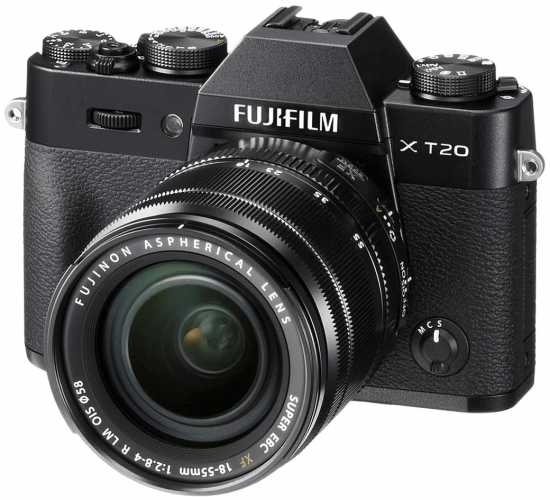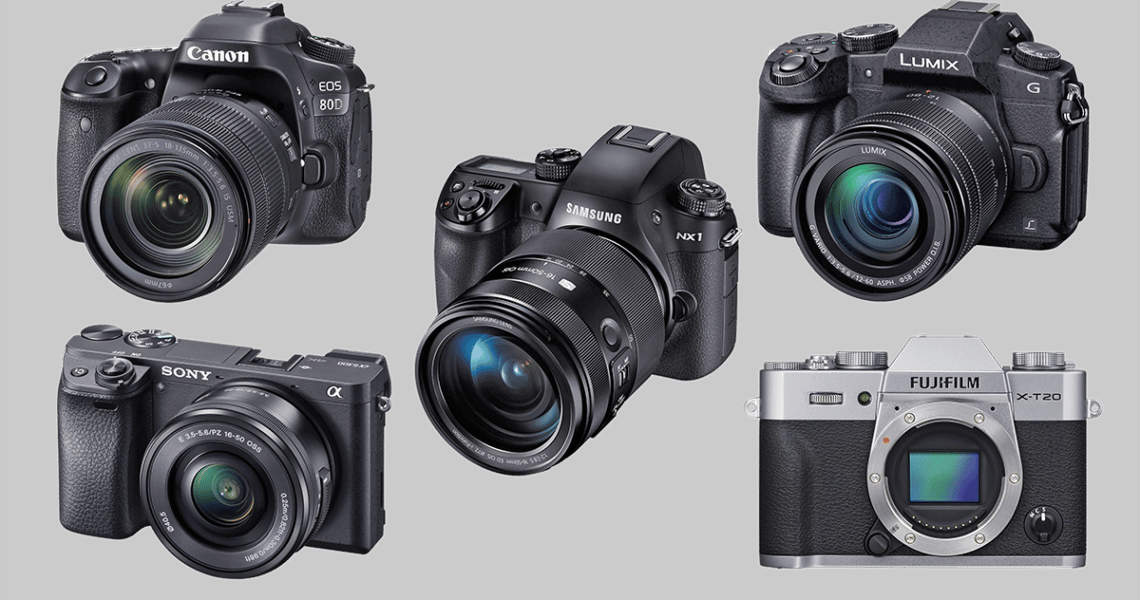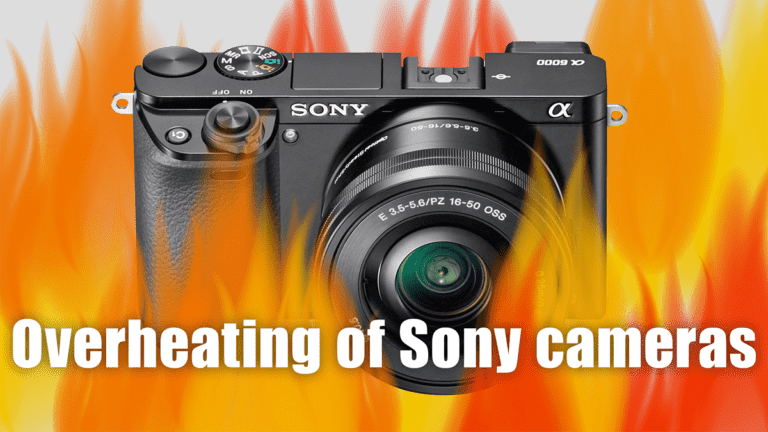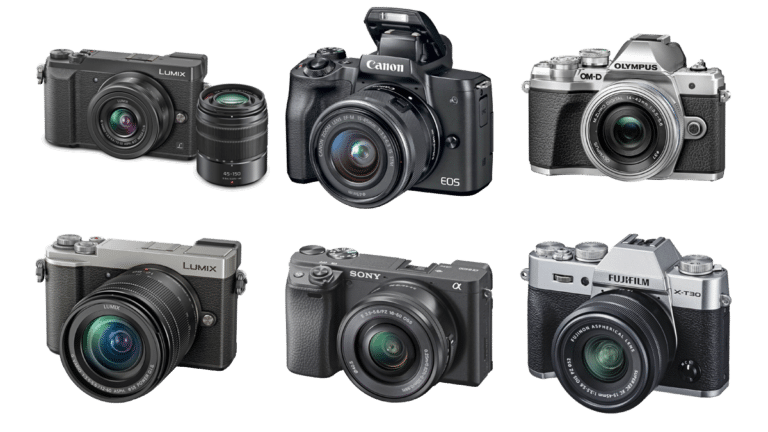The best cameras for shooting video about 1500 USD at the beginning of 2018
By Andrew LazarevArticle about best cameras and lenses for photo and video shooting at mid-prices range about USD 1,500 at the end of 2017
Hello! Why exactly 1500 dollars? Because adequate cameras with good optics, suitable for near-commercial video shooting, begin with this price.
When customers ask: why do videographers set such a price for video shooting? – the answer is because the equipment has a payback period and a service life and the final term must of course be greater than the first. Otherwise, there is no point in this business.
Why this review does not consider video cameras – see above.
So, number one. The best camera for shooting video at the beginning of 2018:

The camera was presented by Samsung on September 15, 2014. Soon after the release of this camera, the company turns off its photo division.
Why does the camera, released 3 years ago, takes the first place in the rating of 2017? – This camera is ahead of its time by three years.
Because, in particular, the video in this camera is recorded using the H.265 codec, which only this year received support in macOS X High Sierra, and, accordingly, can be used without re-encoding in the editors of FCPX, Adobe Premiere and DaVinci Resolve. Before the release of this operating system, the materials shot with this camera had to be re-encoded first by codecs that were supported by video editors in 2014 (for example, in H.264 or Apple ProRES).
Also:
- this is the first camera with sensor APS-C, made using BSI technology (backlighting of the sensor). Early this technology was available only in smaller sensors (mainly in smartphones)
- camera records excellent SHARP video in both 1080p @ 60 and 4K @ 30 formats. Many modern cameras still lose the sharpness of the picture if the shooting goes to 1080p when the camera can write in 4K (for example, the camera Sony A6300 has this feature)
- camera has a hybrid phase-contrast autofocusing system, the quality of which is not inferior to the Sony A6300 and Canon 80D
- for the NX system there is a qualitative optics at an adequate price, for example a lens 16-50 / 2.8
- camera is capable of giving an external signal to a video recorder with a chroma subsampling of 4:2:2
- excellent BSI sensor allows you to shoot in low light conditions
- camera does not overheat when shooting a long-time video
- NX1 has a headphone output
- on an excellent bright OLED screen, the picture is visible on a sunny day, and the touch screen allows you to select the AF point by touching the screen.
Disadvantages of the Samsung NX1 are:
- there are no new devices on sale. You can buy only used one from 650 $ in foreign photo shops. Hucksters on Ebay want much more money, but even there the body with a kit lens can be taken from 1200 $. Also, you need to take care of the purchase of spare batteries, since no one guarantees their availability for sale in the future
- in the NX system, there are no inexpensive system flashes from Chinese manufacturers. After all, it’s still a camera that takes pictures very well.
The camera replaced the Sony A6000 and brought video recording of 4K to the APS-C camera manufacturer. You can buy a new camera for 900 USD, and a excellent used SELP18105G lens can for 600 USD.
Thanks to this lens, the camera turned out to be on the second place of the rating. What’s so good about this lens? At other manufacturers you will not find such a glass for such a price. And all the fairy-tales about expensive Sony optics on the fact of the presence of this lens are to put it mildly not grounded.
Advantages of this lens:
- internal focusing and internal zoom. This is not a vacuum cleaner. With frequent changes in the focal length, you do not collect dust inside; lens’s body is closed and has a dust and moisture protection
- power zoom – few competitors’ lenses have a servo drive in universal zoom lenses, although some of these competitors are targeted specifically for video recording. At the same time, the servo drive is almost noiseless, which is especially valuable for video shooting
- lens is sharp over the entire range of focal lengths
- optical stabilizer in the lens is excellent! Probably there are no more lenses at a similar price with such a good stabilizer in any system among competitors.
The drawbacks of this lens are minimal:
- during reportage photography it lacks sometimes the speed of changing the focal length
- the stabilizer and the zoom drive consume electricity; but if you shoot a video with a powerbank, then this drawback can be forgotten.
Now about the camera itself.
A feature of shooting a video in this camera is that the video is taken at a resolution of 6K, and then compressed by a camera processor in 4K or Full HD.
As a result, the video taken in 4K resolution has excellent sharpness. And in terms of sharpness, this video is even better than the full-frame Sony A7SII companion.
But the internal camera 1080p for sharpness is worse than the one shot by the camera 4K, and then reduced by resolution to 1080p in the video editor.
The A6300 uses a new (in comparison with the A6000) BSI APS-C sensor.
But many people leave this camera because of one problem: camera overheating during long-term video shooting. The processor overheats mainly when shooting dynamic scenes. Since the processor in the camera does not have any cooling system at all.
The truth in the latest firmware the ability to disable this supposedly protection from the supposedly overheating was added – still … in the back of the breathing camera Lumix G80 (85) is breathing under the neck …
Advantages of the camera:
- excellent quality 4K video recording
- the maximum length of the video is removed by an elementary patch of the firmware; the camera does not split video into separate fragments when using memory cards with a capacity of 64 GB or more
- you can shoot video in logarithmic S-LOG profiles for chroma correction on postproduction
- high signal to noise ratio of the camera sensor and adequate operation at high ISO
- good built-in microphone and excellent automatic adjustment of sound recording level.
Disadvantages:
- overheating of the camera’s processor during long-term video shooting of dynamic scenes
- a small capacity of the native battery (it is corrected using an external power suplies)
- incorrect shooting of scenes illuminated with blue LEDs
- dim glaring monitor’s screen.
The first and the third drawbacks can be corrected using an external video recorder. However, in this case, we no longer fit into the budget of 1500 USD, especially if we are talking about a 4K video recorder.

Finally, Fujifilm released a camera that can adequately shoot a video. Before the X-T2 and X-T20 cameras, Fujifilm had some difficulties with providing adequate video quality, because the sensor used in the camera of this manufacturer with a non-Bayer filter requires more processing power from the processor when image resizing is read from the entire sensor to 4K or Full HD video formats.
But with the release of the new 24 MP sensor and the new CPU – X-Processor Pro, Fujifilm managed to align the situation with the video shooting. Autofocus when shooting video works fine, but worse than the Sony A6300.
The camera can be purchased with an excellent light sharp kit lens in a metal casing.
X-T20 shoots excellent video, sharp as in 4K, and Full HD.
The camera’s touch screen allows you to select the autofocus point by touching the screen.
The camera can be bought only if you are ready to put up with the restriction on the duration of continuous video shooting.
Taking into account drawbacks for shooting a video, you can note:
- limit the length of continuous video shooting
- the screen of the camera is not flip-out
- camera sometimes (much less often than the Sony A6x00) is turned off by overheating during long video shooting
- 2.5 mm jack for microphone input – this is not quite a typical connector for external microphones and will have to buy an adapter to 3.5 mm jack; but the price is only 1 $.
So why is this camera in third place in the rating, not lower? – because the camera also takes pictures. And it takes pictures of the X-T20 perfectly! For the quality of the photo with this camera, only Samsung NX1 can compete in this review, but with Fujifilm X-T20 you can use system flash units and third-party radio synchronizers (for example, Godox).

This is the first camera in the review, which most likely can not be used for commercial photography. It is also the first and only camera in the review with autofocus, which is difficult or impossible to use for video shooting. But this is the only camera in the review with a stabilized sensor.
The camera needs to be bought with a lens not worse than Lumix G 12-35 / 2.8, otherwise commercial shooting of video with this camera will become doubtful, because The maximum operating ISO of this camera objectively ends at ISO1600.
The sensor with the Live-MOS architecture, used in the Lumix and Olympus cameras, does not tolerate shooting under artificial lighting with flickering light (fluorescent or cheap LED lighting) at not multiple frame rates, regardless of whether you shoot in PAL or NTSC at the current frequency in network 50 or 60 Hz (depending on the region in which you live).
And if you are ready to put up with the drawbacks listed above, as well as with the price for Lumix and Olympus optics, then the camera, when filming, you will be pleased with the following:
- sharp picture when shooting video in both Full HD and 4K
- good tonal range, color profiles and a configurable dynamic range compressor
- excellent bright flip-out touch-screen
- double image stabilization when shooting at 4K – optical in the lens + sensor
- a satisfactory shooting time from a single battery and the possibility of powering the camera from a powerbank (via a voltage-up inverter).
This is a favorite video camera of middle-level videoblogers.

The only digital SLR camera in the review with the best autofocus. Also this is the only camera in the review that does not know how to shoot 4K videos. But the Full HD video that this camera shoots can not be called the sharpest among the cameras of this review.
This camera will not be able to shoot video on a bright sunny day through the viewfinder built into the camera, since it’s optical and does not work when the mirror is turned up.
So why did this camera get into this review at all?
- mainly due to perfect autofocus
- on this camera you can find an excellent second-hand optical equipment for both native and third-party optics at same prices
- D80 has an excellent rotary-folding touch screen with the ability to autofocus touching the screen
- camera has a headphone output
- on some lenses of the EF-S system, you can buy a servo drive zoom
Comparison of the main characteristics of the best cameras for video with a price of about 1500 USD at the beginning of 2018
Next, I will give in the summary table the key features of the cameras in the order of 1-5 according to their rating in this article:
1. Samsung NX1
2. Sony A6300
3. Fujifilm X-T20
4. Lumix G80(G85)
5. Canon 80D
| Capabilities / Number in rating | 1 | 2 | 3 | 4 | 5 |
| 1. Shooting 1080P@60 | + | + | + | + | + |
| 2. Shooting 4K@30 | + | + | + | + | – |
| 3. Microphone input | + | + | ? | + | + |
| 4. Headphones output | + | – | – | – | + |
| 5. Chroma and/or gamma profiles | + | + | + | + | + |
| 6. High ISO shooting | + | + | + | – | ? |
| 7. Convenient screen | + | – | – | + | + |
| 8. Touch screen | + | – | + | + | + |
| 9. Shooting with the viewfinder | + | + | + | + | – |
| 10. Contignious autofocus | + | + | + | ? | + |
| 11. Sensor’s stabilizer (IBIS) | – | – | – | + | – |
| 12. The camera does not overheat | + | – | – | + | + |
I hope that the information in this article will be useful to you when choosing a camera for your needs and shooting conditions if you have 1500 USD to buy such equipment.
Read also:
© 2017 Andrew Lazarev Production – videography, photography, video editing in Kharkiv and the Kharkiv region, Ukraine.





